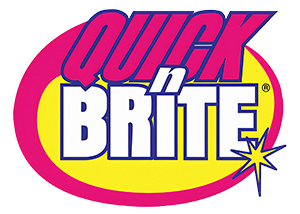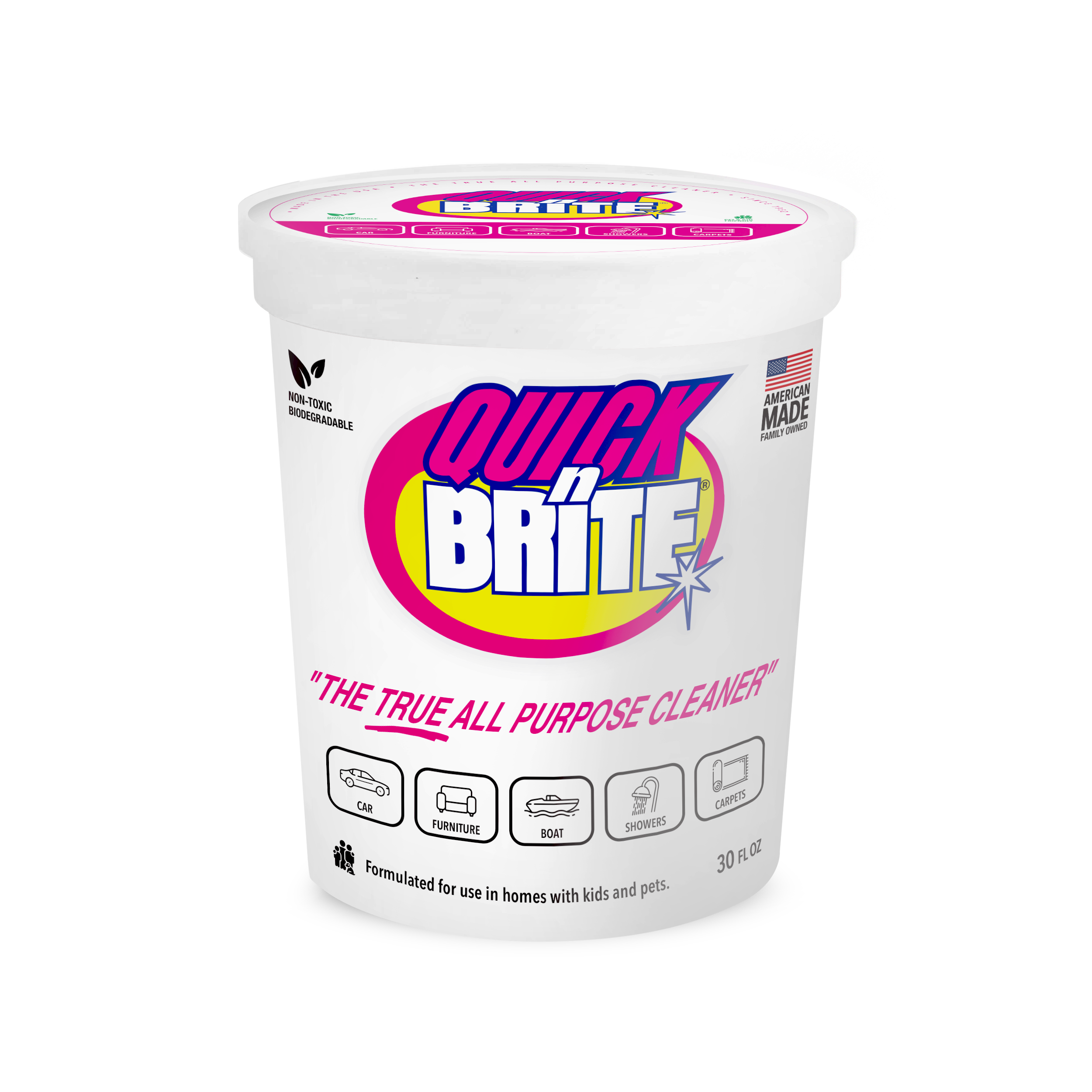Tile, while porous, can truly enhance the look of your kitchens, bathrooms, and other areas in your home, especially with regular cleaning. However, it tends to gather dirt and grime quickly, emphasizing the need for consistent maintenance. Whether it's mildew in the bathroom, cooking splatters in the kitchen, or mud stains in the foyer, using the right cleaning solution can prevent dirty tile from making an entire room feel less clean.
The good news is that you don't need any special tools or cleaners. Quick ‘n Brite’s all-natural, all-purpose products and water can do the trick. You can keep your tile looking great with just a little effort, the right techniques, and occasional polishing.
"Maintaining clean tile and grout is simpler than you think. By using eco-friendly solutions and following a few straightforward tips, you can effortlessly create a sparkling home."
How Often to Clean Tile and Grout
How often you should clean your tile and grout depends on how busy the area is. For places like the kitchen and main bathroom that see a lot of traffic, a weekly cleaning might be needed. For rooms that aren't used as much, you can probably wait a few weeks between cleanings. The important thing is to keep an eye on the condition of the tile and grout and adjust your cleaning schedule based on how quickly dirt builds up.
Materials Needed for Cleaning Tile
Gather a few items for cleaning tile and grout effectively. Here's a handy list:
- Microfiber cloths (included in our Kit)
- A bowl
- A spray bottle (included in our Kit!)
- Scrub brush or sponge
- Warm water
- Quick ‘n Brite’s The Ultimate Cleaning Starter Kit
These items will help you get the cleaning job done efficiently.
How to Clean Tile
When it's time to spruce up your tiles, skip harsh chemicals. Vinegar, even when diluted, is too acidic and can damage grout and etch natural stone tiles. For most tile cleaning, including porcelain and ceramic, you only need two simple ingredients: warm water and Quick ‘n Brite’s Concentrated Cleaner.
- Fill a spray bottle with warm water and a few drops of the Concentrated Cleaner.
- Spray the solution on the tile surface, whether it’s a bathroom tile or backsplash.
- Wipe the area with the damp microfiber towel or cloth. For tougher stains, using a steam cleaner can be very effective. Steam cleaning is especially useful for tile flooring and floor tile grout. This method also works well for removing spills and grime without any harsh chemicals.
How to Remove Stains From Tile
If stubborn stains persist, try our Quick 'n Brite All Purpose Cleaning Paste. First, spread the paste over the stained tile and let it sit for 15 to 20 minutes. Then, gently scrub the area with a brush or sponge. Rinse the tile with warm water and dry it with a microfiber cloth for the best results.
Materials Needed for Cleaning Grout
For cleaning tile and grout effectively with a proper cleaning solution, gather some materials. Here's a list to help organize your cleaning session:
- Grout cleaner (such as QnB All Purpose Paste Cleaner)
- An old toothbrush or grout brush
- Microfiber cloth
- Damp sponge
- Scrub brush
How to Clean Grout
Routine maintenance and cleaning of tile and grout are essential, as grout can get quite dirty and is often porous, depending on its material. Traditional grout is mainly sand and cement, while modern versions may include latex for better stain resistance. No matter what kind of grout you have, our pink paste works wonders.
Here’s what you do:
- Open the paste.
- Spread the paste on the grout lines and scrub with a brush.
- Let it sit for about 15 minutes.
- Rinse with warm water.
- Dry the grout with a microfiber cloth. This method can really refresh your grout with minimal elbow grease!
How to Remove Stains From Grout
Removing stains from grout can be a bit tough, but you've got this. Start by using the QnB pink paste! Apply the paste to the grout stains and scrub with a brush. Let it sit for about 15 minutes. After, rinse the grout with warm water and dry it with a microfiber cloth.
For mold or mildew, consider using chlorine bleach, but be cautious as it can lighten colored grout and definitely remember: PROPER VENTILATION. Avoid using steel wool since it can damage the grout. Get your grout looking fresh and clean!
How to Maintain Tile and Grout
Reduce Moisture Buildup
In bathrooms, it's important to wipe down tiles with a squeegee or a clean microfiber cloth after using the shower to reduce the cleaning required later on. This will help prevent hard water stains and soap scum. Running the exhaust fan during and for 10 to 20 minutes after a shower will also reduce humidity and moisture, which helps prevent mold growth on the grout and keeps the bathroom easier to clean.
Avoid Strong Cleaners
Stay clear of heavy-duty chemical cleaners since they can be harsh on grout. This includes acidic cleaners like vinegar and lemon juice, which can erode the grout over time and cause discoloration. Instead, choose gentler, pH-neutral cleaning solutions that won't damage the grout. These milder cleaners still do a great job at cleaning tile and grout, keeping them looking their best without compromising their integrity. Additionally, pH-neutral cleaners are often more environmentally friendly, making them a great choice for eco-conscious homeowners.
Apply Grout Sealant
Using a grout sealer is important for ongoing maintenance because it fills the pores in the grout. This helps stop grime, dirt, and mold from getting into the porous material. Depending on how much the area is used, grout may need to be sealed once or twice a year. Make sure to wait at least 24 hours between deep cleaning and applying the sealer to ensure the grout is fully dry. This simple step can make the kitchen, bathroom, or mudroom much more manageable to clean.
When to Call a Professional
If you see your tile and grout becoming widely discolored, it's time to reach out to a professional. Ignored grout, being porous, can start to loosen, allowing water to seep behind the tiles. This can lead to hidden mold growth that you can't easily spot. It's important to address these issues early to avoid more significant damage. Professional cleaning can restore the beauty of your floors and prevent these problems from getting worse.
Frequently Asked Questions
What is the best way to clean tile and grout?
We've found that using Quick 'n Brite All Purpose Cleaning Paste works wonders for tile and grout. Spread the paste on your grout lines with a brush, let it sit for 5-10 minutes, and then scrub away the dirt.
What are some tips for cleaning grout in the shower?
For cleaning shower grout, it's helpful to apply a cleaner directly to the grout lines. Let it sit for about 10-15 minutes to loosen the grime. Our products or a commercial grout cleaner can be used. Use a stiff nylon brush to scrub the grout, then rinse thoroughly with water.
How can you clean floor tile grout without needing to scrub hard?
To clean floor tile grout without heavy scrubbing, spraying a bleach-based cleaner is very effective. These cleaners often work by breaking down stains with minimal need for scrubbing. Always ensure proper ventilation and rinse the area well afterward.
How do you clean grout lines without causing damage?
Avoid using metal brushes, as they can scratch and damage the grout. Stick to nylon or other soft-bristle brushes. When applying cleaning solutions, use non-abrasive substances like baking soda or gentle commercial cleaners. After cleaning, applying a silicone-based sealer can protect grout from future stains.
















